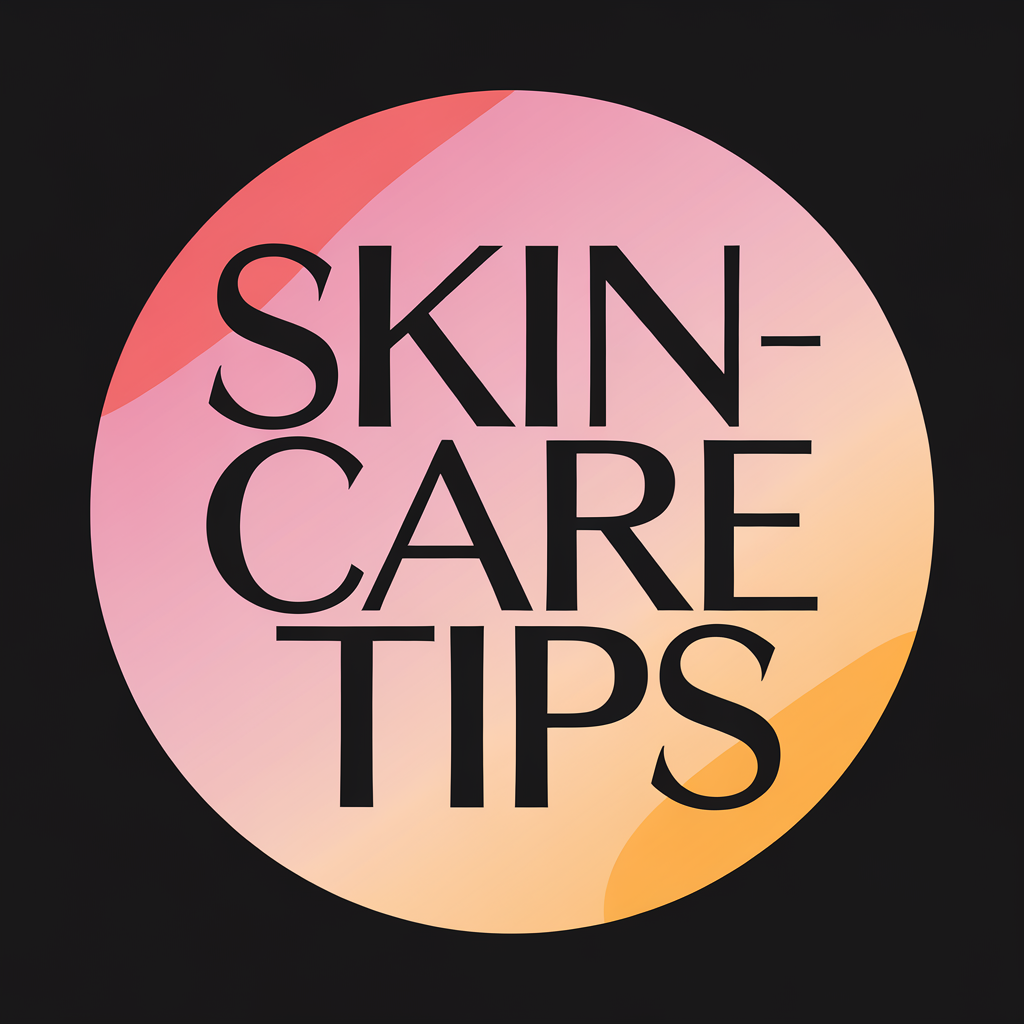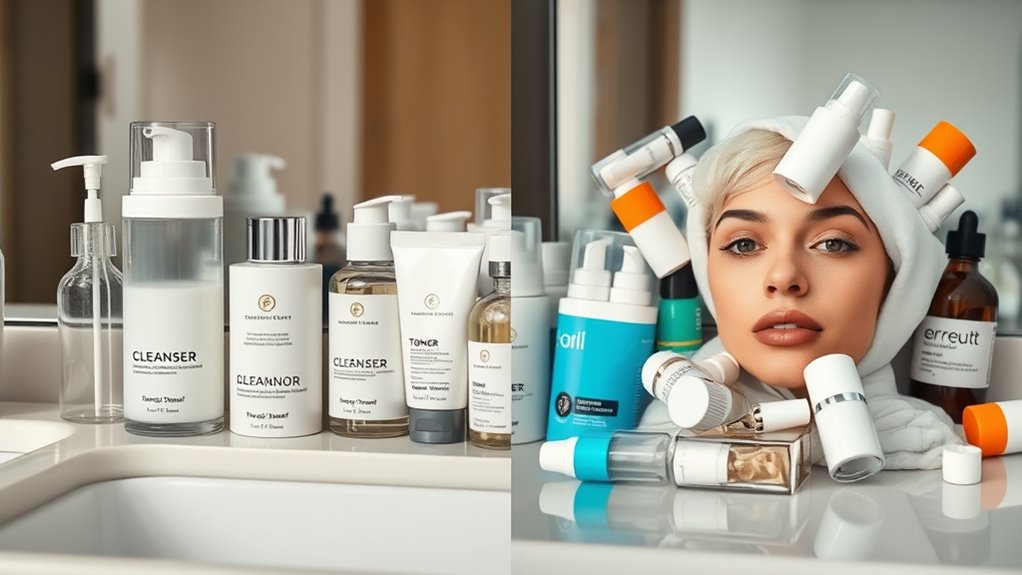The Right (and Wrong) Way to Layer Skincare Products Daily
You’ve likely wondered if your daily skincare layering is effective, but getting the order wrong can block key benefits. Start with a cleanser to clear impurities, then build with toner, serums, moisturizer, and sunscreen for optimal results. Stick around to avoid common errors that could undermine your skin’s radiance.
Key Takeaways
- Start with a cleanser to remove dirt and oil, ensuring better absorption of subsequent products.
- Apply toner after cleansing to balance pH and prepare skin for serums.
- Layer water-based serums before oil-based moisturizers to allow deep penetration.
- Avoid applying moisturizer first, as it blocks serum absorption and reduces effectiveness.
- End with sunscreen as the final step to protect against UV rays without disrupting the routine.
The Ideal Order for Skincare Products
Have you ever wondered how to layer your skincare products for the best results?
Effective daily skincare layering starts with the lightest products to ensure deep absorption and avoid irritation.
Begin with a cleanser to remove dirt and oil, preparing your skin for what’s next.
Follow with a toner to balance pH and enhance penetration.
Then, apply water-based serums for targeted benefits, as they sink in quickly.
Layer on oil-based moisturizers to lock in moisture, and for daytime, finish with sunscreen.
This logical order maximizes efficacy, based on skin science, preventing buildup and promoting healthy results.
Adopting the thinnest to thickest rule can significantly enhance product absorption and overall effectiveness.
Essential Products for Daily Layering
The essential products for daily layering include a cleanser, toner, serum, moisturizer, and sunscreen.
You start with a cleanser to remove dirt and impurities, preventing buildup that could lead to issues, as dermatologists recommend for clear skin.
A toner then balances your pH and refines texture, enhancing product absorption based on clinical evidence.
Choose a serum for targeted benefits, like antioxidants for protection or hyaluronic acid for hydration.
Apply moisturizer to lock in moisture and strengthen your barrier, and finish with broad-spectrum sunscreen to shield against UV damage, promoting long-term health.
This practical lineup keeps your skin vibrant.
To maximize effectiveness, it’s important to consider the absorption rates of each product for better results.
Common Layering Mistakes to Avoid
As you build your skincare routine, you’ll often encounter mistakes like applying products in the wrong order, which can disrupt their effectiveness.
Overloading layers or mixing incompatible ingredients also leads to irritation and poor absorption, as studies show these errors compromise skin barrier function.
To avoid these issues, it’s essential to learn about the science behind product layering.
Wrong Application Order
One frequent mistake in layering skincare products is applying them out of sequence, which disrupts ingredient absorption and can irritate your skin. This error often stems from misunderstanding product formulations, leading to ineffective results or reactions. To clarify, here’s a breakdown of common missteps:
| Common Error | Problem Caused | Correct Approach |
|---|---|---|
| Applying moisturizer first | Blocks serum penetration | Use serums before moisturizers |
| Sunscreen before antioxidants | Reduces antioxidant efficacy | Apply antioxidants first |
| Oil-based before water-based | Prevents water-based absorption | Layer water-based products first |
| Toner after creams | Dilutes cream benefits | Apply toner right after cleansing |
| Exfoliator last | Irritates freshly layered skin | Use exfoliators early in routine |
Overloading Product Layers
While you pile on multiple skincare layers in hopes of better results, overloading can overwhelm your skin’s barrier, leading to irritation, clogged pores, and reduced product efficacy.
Dermatological research shows that excess layers trap ingredients, hindering absorption and causing inflammation.
To avoid this, stick to 3-5 essential steps per routine; for instance, apply only what your skin needs, like a serum followed by moisturizer.
Monitor for signs like redness—it’s your cue to simplify.
This approach maintains barrier health, ensuring products work effectively without overwhelming your complexion.
Mixing Incompatible Ingredients
Another common layering mistake is mixing incompatible ingredients, which can disrupt your skin’s balance and cause irritation. You’ll irritate your skin if you combine acids like AHAs with vitamin C, as studies show this reduces efficacy and increases pH instability. To prevent this, check labels and wait between applications.
| Incompatible Pair | Potential Issue | Solution |
|---|---|---|
| AHAs + Vitamin C | Irritation | Apply separately |
| Retinol + Benzoyl Peroxide | Reduced effectiveness | Use at different times |
| Exfoliants + Oils | Over-drying | Layer oils first |
Always patch test products to maintain healthy skin—your routine should support, not sabotage, it.
Preparing Your Skin Before Application
Before you apply any skincare products, start by cleansing your face to remove dirt, oil, and makeup, which ensures a clean base for better absorption.
You’ll then apply a toner to balance your skin’s pH and minimize pores, drawing on dermatological advice that this step enhances product efficacy.
These simple preparations make your layering routine more effective and help prevent common issues like irritation.
To optimize your routine, consider your skin type when determining how often to cleanse.
Cleanse Face
Before applying any skincare products, cleanse your face to remove dirt, oil, and impurities that can block pores and reduce product effectiveness.
This essential step, supported by dermatological studies, prepares your skin for optimal absorption and prevents breakouts.
Choose a gentle, pH-balanced cleanser to maintain your skin’s barrier.
- Feel the warm water cascade over your face, washing away the day’s buildup for a refreshed sensation.
- Watch as the cleanser foams lightly, drawing out embedded pollutants like a magnet.
- Visualize your skin emerging clear and smooth, primed for layers that work their best.
Apply Toner
Toner refines your skin’s surface after cleansing, balancing pH levels and removing any lingering residue to enhance product absorption.
Once you’ve cleansed, gently pat toner onto your face using a cotton pad or clean hands, focusing on areas like the T-zone for even distribution.
This evidence-based step, supported by dermatological research, optimizes your skin’s barrier and boosts subsequent product efficacy.
Choose alcohol-free formulas to prevent dryness, and apply twice daily for best results.
You’ll notice improved hydration and texture, making toner a practical must for effective layering without skipping essentials.
Tailoring Routines for Different Skin Types
How do you customize your skincare routine to match your skin type, whether it’s oily, dry, or combination?
For oily skin, opt for lightweight, oil-free layers to minimize excess sebum without clogging pores.
Dry skin benefits from richer, emollient products that seal in hydration and repair barriers.
Combination types require balanced layering, addressing oily zones with mattifiers and dry areas with moisturizers.
-
Envision oily skin: A matte finish from gel-based products that absorb quickly, controlling shine without heaviness.
-
Picture dry skin: Creamy layers enveloping your face, creating a barrier that locks in moisture for lasting softness.
-
Imagine combination skin: Targeted zones where lighter formulas on the T-zone contrast with richer applications on cheeks for even harmony.
To ensure your routine is effective, first identify your true skin type by following steps to properly assess common signs of misdiagnosis.
Techniques for Optimal Product Absorption
To maximize your skincare routine’s effectiveness, focus on techniques that enhance product absorption and minimize waste.
After cleansing, pat your skin dry but leave it slightly damp; this boosts hydration and aids penetration, as dermatologists confirm.
Apply serums and treatments with gentle patting motions to distribute evenly and prevent irritation.
Wait 1-2 minutes between layers, allowing each to fully absorb and avoid pilling.
Always start with lighter textures like essences before moving to richer creams, ensuring optimal efficacy and reducing product overlap for healthier skin.
To complete your routine effectively, remember to end with sunscreen application for protection against UV rays, as recommended in proper layering sequences.
Tips for Maintaining an Effective Routine
Why overlook the key to a lasting skincare routine?
Consistency drives results, backed by dermatological research showing regular layering enhances skin barrier function and minimizes irritation.
Adapt your regimen proactively to maintain efficacy.
-
Picture yourself performing a daily ritual: gently cleansing to reveal fresh skin, then layering serums that penetrate like a nourishing mist.
-
Envision seasonal adjustments: swapping lightweight gels for richer creams in winter, imagining a cozy shield against dry air.
-
Imagine tracking progress weekly: noting smoother texture in a mirror, fine-tuning products for that enduring, radiant glow.
To achieve optimal results, always follow the correct sequence when layering skincare products, as this ensures maximum absorption and effectiveness.

